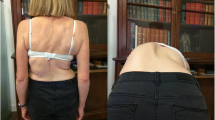Summary
The conservative treatment of scolioses has evolved in a spectacular way from the 60's onwards with the birth of glued plasters, the Cotrel frame and the lyonnais braces in plexidur. In the past “the disgrace of orthopaedics”, idiopathic scoliosis progressively saw its prognosis brighten up, at the cost nevertheless of a constraining and lengthy treatment. However, the treatment must be varied depending on several parameters: the importance of the scoliosis, the localization of the curvature, the bone age, the chronological age. The ideal case for the conservative treatment is that of a lumbar or thoracolumbar scoliosis with an initial Risser test inferior to 2. For thoracic curvatures, the conservative treatment is continued only if the angular gain remains superior to 30% during treatment, otherwise, it is better to stop the conservative treatment and recommend the surgery.
Résumé
Le traitement orthopédique des scolioses a évolué de façon spectaculaire à partir des années 60 avec l'apparition des plâtres collés, du cadre de Cotrel et des corsets lyonnais en plexidur. Jadis “opprobre de l'orthopédie”, la scoliose idiopathique a vu progressivement son pronostic s'éclairer, au prix cependant d'un traitement contraignant et de longue durée. Il faut cependant savoir moduler le traitement en fonction de plusieurs paramètres : l'importance de la scoliose, la localisation de la courbure, l'âge osseux, l'âge d'état civil. Le cas idéal pour le traitement orthopédique est celui d'une scoliose lombaire ou thoraco-lombaire avec un test de RISSER initial inférieur à 2. Pour les courbures thoraciques, le traitement orthopédique n'est à poursuivre que si le gain angulaire reste supérieur à 30 % au long du traitement, sinon, il vaut mieux cesser le traitement orthopédique et indiquer la chirurgie.
Similar content being viewed by others
Bibliographie
Kehr P, Safaoui A (1968) Du traitement chirurgical des scolioses. Strasb Med 8: 859–861
Jung A, Kehr P, Lang G, Sall B, Arama M (1970) Notre expérience des scolioses graves traitées au service de fin 1966 à 1968. A propos de 58 cas. J Med Strasb 1: 61–68
Kehr P, Lang G, Truschel G, Alchab M, Hamid M, Boistelle J (1974) Du traitement orthopédique des scolioses structurelles graves. Le Poumon et le Coeur. XXX, 1: 39–44
Lang G, Kehr P, Paternotte H (1977) Traitement orthopédique des scolioses graves. J Med Strasb 8: 27–34
Steib J-P, Lang G, Kehr P, Trensz Th (1986) Aspects actuels de la chirurgie de la scoliose. Rev Méd de l'Assurance Maladie 2: 8–12
Dubald C (1989) Le corset plexidur actif dans le traitement de la scoliose idiopathique de l'adolescent. A propos de 54 cas. Thèse Strasbourg 1989 n° 52
Steib J-P, Pierchon F, Kehr P, Lang G (1993) 100 CCD with one year minimum follow-up - 10th International Congress on C-D instrumentation, Congress Book, p 61
Author information
Authors and Affiliations
Rights and permissions
About this article
Cite this article
Kehr, P., Bogorin, I., Poos, J. et al. Expérience du traitement Lyonnais à l'Hôpital Stéphanie. Orthop Traumatol 4, 175–178 (1994). https://doi.org/10.1007/BF01788463
Published:
Issue Date:
DOI: https://doi.org/10.1007/BF01788463




